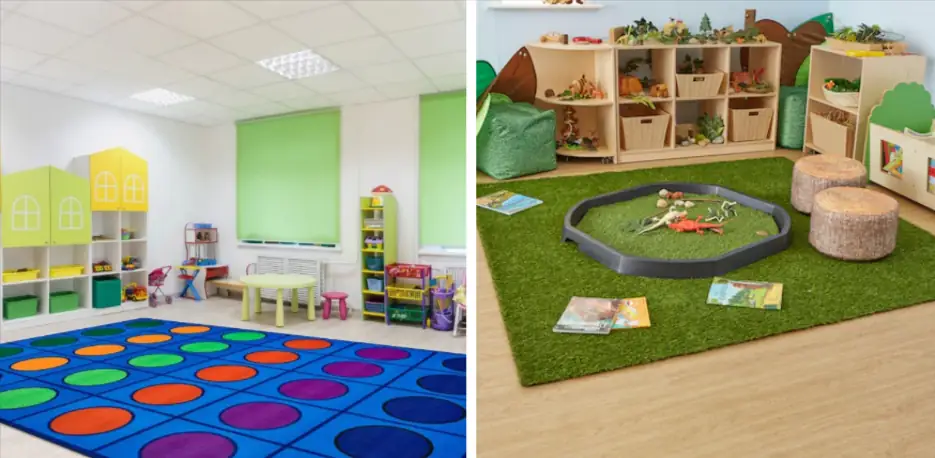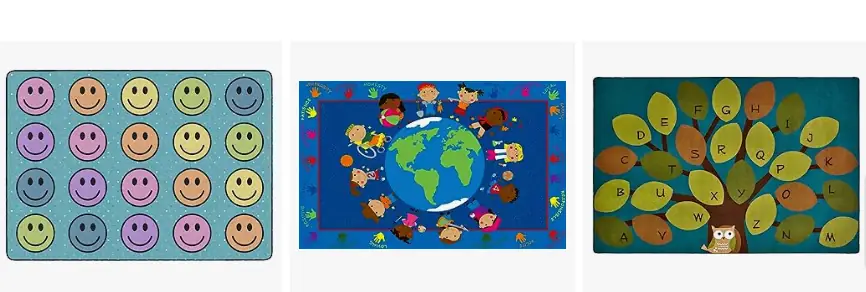Last updated on October 29th, 2023 at 02:41 am
In the realm of educational environments, the choice of classroom flooring has often been a matter of practicality and aesthetics. One particular option that has gained attention is classroom carpets.
Why Do Classrooms Have Carpets?
Classroom carpets have found their way into educational settings for several compelling reasons. First and foremost, they provide a comfortable and inviting atmosphere, making learning spaces more engaging for students. But there’s more to this story. Let’s break it down.
Classrooms may have carpets for several reasons, although it’s important to note that not all classrooms have carpets, and the decision to use carpets can vary depending on factors like the educational philosophy of the school, budget constraints, and specific needs of the students.
Here are some reasons why classrooms might have carpets:
- Comfort: Carpets can provide a more comfortable and cozy environment for students. Sitting or standing on a carpeted floor can be more comfortable than on a hard, cold surface, especially during activities like reading time or group discussions.
- Noise Reduction: Carpets can help reduce noise in the classroom. They absorb sound and can minimize echoing, making it easier for students to concentrate and for teachers to be heard. This is particularly important in classrooms with younger children who might be more sensitive to noise.
- Safety: Carpets can provide a safer surface for students, especially in early childhood education settings. They can help cushion falls and reduce the risk of injuries during playtime.
- Visual Appeal: Carpets come in various colors and designs, which can make the classroom more visually appealing and create a welcoming atmosphere. A well-designed carpet can enhance the learning environment.
- Thermal Insulation: Carpets can provide some degree of thermal insulation, helping to maintain a more comfortable temperature in the classroom. This can be especially important in regions with extreme weather conditions.
- Acoustic Benefits: In music classrooms, dance studios, or other specialized learning spaces, carpets can be used to improve acoustics. They can help absorb sound and create a better environment for music and performing arts instruction.
- Allergen Control: Some classrooms use carpets designed to reduce allergen buildup, which can be important for students with allergies or respiratory issues. These carpets are typically treated to resist allergens and can be cleaned more easily.
- Learning Zones: Carpets can be used to define specific learning zones within a classroom. For example, a carpeted reading corner or a designated area for group activities can help organize the space and facilitate different teaching approaches.
It’s worth noting that there are also disadvantages to using carpets in classrooms. They can be more difficult to clean than hard surfaces, and they may harbor allergens or germs if not properly maintained.
Additionally, some educators prefer hard floors for certain types of activities, such as science experiments or art projects that could result in spills.
Benefits of Carpeted Areas in Classrooms
When contemplating whether to incorporate classroom carpets, it’s essential to consider the potential benefits they offer:
1. Comfort and Safety
- Comfort: Carpets create a cozy ambiance, making students feel more at ease, which can be particularly beneficial in primary education.
- Safety: They can help minimize injuries from slips and falls, a crucial aspect in childcare and primary school settings.
2. Acoustic Enhancement
- Noise Reduction: Carpets absorb sound, reducing noise levels in classrooms. This can contribute to a more focused learning environment.
3. Versatility
- Flexible Learning Spaces: Carpets allow for flexible seating arrangements, promoting collaboration and interaction among students.
Should Classrooms Have Carpets?
The decision to include carpets in a classroom isn’t a one-size-fits-all solution. It depends on various factors, including grade level, safety considerations, and maintenance capabilities.
Let’s examine the pros and cons.
Pros of Classroom Carpets:
- Enhanced comfort and safety
- Improved acoustic environment
- Versatile seating options
- Creates a warm and inviting atmosphere
- Suitable for primary and early childhood education
Cons of Carpet in Classroom:
- Maintenance challenges
- Potential for allergens and dust
- Fire safety concerns
- Not always appropriate for higher grade levels
Safety Aspects of Classroom Rugs and Carpets
One crucial aspect of considering classroom carpets is their safety implications. Are carpets safe in classrooms? Let’s explore this further.
Fire Safety:
- Carpets should meet fire safety standards, and classrooms should have proper fire evacuation plans in place.
Allergies and Air Quality:
- Regular cleaning and maintenance can mitigate allergen concerns.
- Consider low-pile carpets to minimize dust accumulation.
Do Carpets Enhance Learning?
A pivotal question in this discussion is whether carpets can enhance the learning experience. Creating a comfortable and engaging learning environment is essential for student success.
Psychological Impact:
- Carpeted classrooms can foster a sense of comfort and security, potentially improving the overall classroom atmosphere.
- Aesthetic Appeal: The design and colors of carpets can have a psychological impact on the learning environment. A visually pleasing and well-designed carpet can contribute to a positive atmosphere, which might indirectly enhance the learning experience.
- Group Activities: Carpets can be used as a designated space for group activities or discussions. Having a defined area for such activities can help promote collaboration and engagement among learners.
- Sensory Stimulation: In early childhood education, textured carpets with different materials or patterns can provide sensory stimulation, which can be beneficial for young children’s development.

What Types of Carpets are Best for Classrooms?
The choice of carpet material and design is crucial to meet the unique demands of classroom settings.
Let’s explore the options.
- Commercial-Grade Carpet Tiles: These are a popular choice for classrooms because they are durable and easy to maintain. Carpet tiles are modular, so if a section gets damaged or stained, you can replace only the affected tiles rather than the entire carpet. They come in various colors and patterns to suit classroom aesthetics.
- Low Pile Carpets: Carpets with low pile, which means shorter and denser fibers, are a good choice for classrooms. They are easier to clean and maintain than high-pile carpets, which can trap more dirt and allergens.
- Nylon Carpets: Nylon is a common material used in classroom carpets due to its durability and stain resistance. It’s also easy to clean, making it suitable for high-traffic areas.
- Carpet with Stain Resistance: Look for carpets with stain-resistant treatments. These can help in case of accidental spills and make cleaning easier.
- Carpet Padding: Consider adding carpet padding beneath the carpet. Padding provides additional cushioning, making the classroom more comfortable and reducing noise. It also extends the life of the carpet by absorbing some of the impact from foot traffic.
- Carpet with Low VOC Emissions: Volatile Organic Compounds (VOCs) can emit harmful fumes, affecting indoor air quality. Choose carpets with low VOC emissions, which are healthier for students and staff.
- Carpet Tiles with Educational Designs: Some carpet tiles come with educational designs, such as numbers, letters, or maps, which can be both functional and visually engaging for young learners.
- Safety Features: Consider carpets with slip-resistant backing to reduce the risk of accidents, especially in early childhood education settings.
- Easy Maintenance: Ensure that the chosen carpet is easy to clean and maintain. Carpets in classrooms are subject to spills and wear and tear, so having a surface that can be easily cleaned is essential.
- Budget Considerations: While quality is important, budget constraints may also play a significant role in your decision. There are options available at various price points, so balance quality and affordability.
Before making a final decision, it’s a good idea to consult with a flooring professional or supplier who can provide recommendations based on your specific classroom needs and budget.
Additionally, consider the age group of the students, the amount of foot traffic, and the overall design and color scheme of the classroom when selecting the best type of carpet for your educational environment.
How Do Carpets Affect Indoor Air Quality?
Concerns about indoor air quality often arise when discussing carpets in classrooms. Addressing these concerns is vital to maintain a healthy learning environment.
Indoor Air Quality Tips:
- Regular Cleaning: Implement a strict cleaning schedule to remove dust and allergens.
- Proper Ventilation: Ensure classrooms have adequate ventilation to circulate fresh air.
Are Carpets Difficult to Clean in Classroom Settings?
Maintaining cleanliness in classrooms with carpets can be a challenge, but it’s not insurmountable. Let’s explore some practical cleaning solutions and maintenance tips.
Cleaning and Maintenance:
- Regular Vacuuming: Regular vacuuming is essential to remove dirt, dust, and debris from the carpet’s surface. High-traffic areas may need daily vacuuming, while less frequented areas can be vacuumed less frequently. Use a commercial-grade vacuum cleaner with HEPA filters to improve indoor air quality.
- Spot Cleaning: Promptly address spills and stains to prevent them from setting in. Use appropriate carpet stain removers or cleaning solutions recommended by the carpet manufacturer. Blot stains rather than rubbing them to avoid spreading.
- Deep Cleaning: Periodically, deep cleaning is necessary to remove embedded dirt and maintain the carpet’s appearance. Common deep cleaning methods include hot water extraction (steam cleaning), dry carpet cleaning, or encapsulation cleaning. The choice of method may depend on the type of carpet and the manufacturer’s recommendations.
- Professional Cleaning: Consider hiring professional carpet cleaning services at regular intervals, typically once or twice a year, to perform deep cleaning and maintenance. Professionals have the equipment and expertise to thoroughly clean and refresh carpets.
- Carpet Protectors: Applying carpet protectors after cleaning can help repel spills and stains, making it easier to clean up accidents.
- Regular Maintenance Schedule: Establish a cleaning and maintenance schedule and stick to it. Regular cleaning prevents dirt and stains from becoming deeply embedded in the carpet fibers.
- Proper Ventilation: Adequate ventilation in the classroom can help carpets dry faster after cleaning, reducing the risk of mold and mildew growth.
Ultimately, the ease of cleaning carpets in classrooms depends on the diligence of the cleaning staff and the implementation of a well-structured cleaning and maintenance plan.
Regular cleaning and immediate attention to spills and stains are key to keeping classroom carpets in good condition.
Cost Considerations of Using Carpets in Classrooms
When considering classroom carpets, cost is a significant factor. Let’s break down the expenses involved.
Cost Factors:
- Initial Installation: Includes carpet purchase and installation costs.
- Maintenance: Regular cleaning and potential replacements over time.
- Long-Term Savings: Consider the potential benefits, such as increased comfort and reduced noise.
Classroom carpet ideas

Do Carpets Promote a Positive Classroom Atmosphere?
The psychological impact of classroom design should not be underestimated. A positive classroom atmosphere can enhance the learning experience.
Psychological Impact:
- Carpeted classrooms can create a warm and inviting atmosphere, potentially contributing to a more positive learning environment.
Are Carpets Suitable for All Grade Levels?
The suitability of carpets in classrooms varies depending on the grade level. Let’s consider the appropriateness for different educational settings.
Grade Level Considerations:
- Preschool and Early Childhood Education: Carpets are commonly used in preschool and early childhood education settings. They provide a soft and comfortable surface for young children to sit, play, and engage in various activities. Carpets with educational designs like letters, numbers, or shapes can also serve as teaching tools. However, it’s crucial to choose durable, stain-resistant carpets that are easy to clean, as younger children are more likely to create spills and messes.
- Elementary School: Carpets can be beneficial in elementary classrooms as well. They provide a cozy and inviting space for group activities, storytime, and discussions. Carpets with bright colors and engaging patterns can help create a positive and stimulating learning environment. Again, durability and ease of maintenance are essential considerations.
- Middle School and High School: While carpets are less common in middle and high school classrooms, they can still be used effectively in specific areas. For instance, they can be used in reading corners, libraries, or smaller breakout spaces where students may benefit from a more relaxed and comfortable setting. In these settings, carpets can contribute to a more welcoming and conducive learning environment.
- Higher Education: Carpets are less frequently used in lecture halls or large university classrooms, where hard flooring surfaces and seating arrangements are typically favored for practical reasons. However, they may be found in areas like student lounges, study rooms, or small seminar-style classrooms.
Classroom Rug Alternatives
While carpets are a popular choice, there are alternative flooring options that schools can consider.
Alternative Flooring:
- Hardwood or Laminate Flooring: Easy to clean and maintain.
- Vinyl Flooring: Durable and available in various designs.
- Area Rugs: Provide the comfort of carpets with easier maintenance.
Are Carpets Eco-Friendly for Classroom Use?
In an era of increasing environmental consciousness, it’s essential to address the eco-friendliness of classroom carpets.
Sustainability Considerations:
- Material Selection: The choice of carpet material has a significant impact on its eco-friendliness. Some eco-friendly carpet materials include:
- Recycled Content: Carpets made from recycled materials, such as recycled PET (polyethylene terephthalate) fibers or recycled nylon, are more sustainable as they reduce the demand for new resources.
- Natural Fibers: Carpets made from natural fibers like wool or sisal are biodegradable and renewable. However, they may be less durable and more expensive.
- Low VOC (Volatile Organic Compounds) Materials: Carpets manufactured with low VOC emissions are better for indoor air quality and reduce harmful chemical exposure.
- Manufacturing Practices: Consider carpets that are manufactured using environmentally responsible practices. Look for certifications like Green Label Plus or Cradle to Cradle, which indicate adherence to strict environmental and health standards.
- Recyclability: Assess whether the carpet can be recycled at the end of its life. Some carpet manufacturers offer take-back programs for recycling old carpets.
- Installation: Consider low-VOC adhesives and methods that minimize waste during installation.
- Maintenance: Proper maintenance can extend the life of the carpet and reduce the need for replacement, which is more environmentally friendly. Regular vacuuming and cleaning can prevent premature wear and reduce the accumulation of dirt and allergens.
- Durability: Choose durable carpets that will have a longer lifespan and require fewer replacements.
- Disposal: Plan for responsible disposal at the end of the carpet’s life, whether through recycling or other environmentally friendly methods.
- Sustainability Certifications: Look for carpets with sustainability certifications, such as LEED (Leadership in Energy and Environmental Design) certification, to ensure they meet specific environmental criteria.
- Local Sourcing: Whenever possible, source carpets from local manufacturers to reduce the environmental impact associated with transportation.
It’s important to note that not all carpets are created equal in terms of their environmental impact. Some carpets may have a significant environmental footprint, while others are designed with sustainability in mind.
When choosing carpets for classroom use, consider your institution’s commitment to environmental responsibility and balance it with factors like cost, durability, and performance.
Ultimately, the eco-friendliness of classroom carpets can be improved by making informed choices during the selection, installation, and maintenance processes, as well as by prioritizing sustainable materials and practices.
Do Carpets Help with Noise Reduction in Classrooms?
Noise reduction is a critical factor in creating an optimal learning environment. Let’s explore how carpets can contribute to noise reduction.
Noise Reduction Benefits:
- Carpets absorb sound, reducing noise levels and creating a more conducive learning environment.
Maintenance Tips for Classroom Carpets
Maintaining classroom carpets is vital for their longevity and hygiene. Here are some practical tips for teachers and school staff.
Maintenance Strategies:
Here are some maintenance tips for classroom carpets:
- Regular Vacuuming: Vacuum the carpet regularly to remove loose dirt, dust, and debris. High-traffic areas may need daily vacuuming, while less frequented areas can be vacuumed less often. Use a vacuum cleaner with a HEPA filter to improve indoor air quality.
- Spot Cleaning: Promptly address spills and stains to prevent them from setting in. Blot the stain with a clean cloth or paper towel to absorb as much liquid as possible. Use an appropriate carpet stain remover or cleaning solution according to the manufacturer’s recommendations. Avoid rubbing the stain, as it can spread it further.
- Deep Cleaning: Periodically, deep cleaning is necessary to remove embedded dirt and maintain the carpet’s appearance. Common deep-cleaning methods include:
- Hot Water Extraction (Steam Cleaning): This method uses hot water and cleaning agents to loosen dirt and then extracts it with a vacuum. It’s effective but may require some drying time.
- Dry Carpet Cleaning: Dry cleaning methods involve using a dry cleaning compound or foam that doesn’t require drying time. This can be advantageous in areas where minimal downtime is essential.
- Encapsulation Cleaning: Encapsulation cleaning uses a specialized cleaning solution that encapsulates dirt and debris, allowing for easy removal.
- Professional Cleaning: Consider hiring professional carpet cleaning services once or twice a year for deep cleaning and maintenance. Professionals have the equipment and expertise to thoroughly clean and refresh carpets.
- Carpet Protectors: After cleaning, consider applying a carpet protector to repel spills and stains, making it easier to clean up accidents in the future.
- Regular Maintenance Schedule: Establish a cleaning and maintenance schedule and stick to it. Regular cleaning prevents dirt and stains from becoming deeply embedded in the carpet fibers.
- Carpet Padding: If applicable, periodically check and replace carpet padding as needed. Damaged or worn padding can affect the carpet’s comfort and performance.
- Ventilation: Adequate ventilation in the classroom can help carpets dry faster after cleaning, reducing the risk of mold and mildew growth.
- Preventative Measures: Implement preventative measures to reduce the amount of dirt brought into the classroom. Place doormats at entrances to trap dirt and encourage students to wipe their feet before entering.
- Rotate Furniture: Periodically move and rotate classroom furniture to prevent excessive wear and tear on specific areas of the carpet.
- Regular Inspections: Conduct regular inspections of the carpet for signs of damage or wear. Address any issues promptly to prevent further deterioration.
By following these maintenance tips, you can keep classroom carpets clean, safe, and in good condition, providing a comfortable and conducive learning environment for students and educators alike.
Regular care and attention to your carpets can extend their lifespan and ensure they remain an asset to the classroom setting.
What is Carpet Time in Primary Schools?
An essential aspect of classroom carpet use in primary education is “carpet time.” What is it, and why is it significant?
Importance of Carpet Time:
- Group Instruction: Carpet time provides an opportunity for the teacher to gather all the students in one central location within the classroom. This facilitates group instruction, allowing the teacher to present lessons, introduce new topics, or review material with the entire class.
- Storytime: One common use of carpet time is for storytime, where the teacher reads aloud to the students. This encourages literacy development, listening skills, and a love of reading.
- Discussion and Sharing: During carpet time, students may have the chance to share their thoughts, ideas, and experiences with the class. This promotes communication skills, active participation, and a sense of community within the classroom.
- Interactive Learning: Teachers often incorporate interactive elements into carpet time, such as educational games, songs, and hands-on activities. These activities engage students and make learning more enjoyable.
- Circle Time: Carpet time is sometimes referred to as “circle time” because students typically gather in a circle on the carpet. This arrangement allows for equal participation and visibility for all students.
- Classroom Management: Carpet time can serve as a time for classroom management, setting expectations, and reinforcing classroom rules and routines.
- Transitions: It can also be used as a transition period between different activities or subjects throughout the day, helping students shift their focus and prepare for the next part of the curriculum.
—
Carpet time is particularly common in early childhood and primary education settings, where young learners benefit from the physical closeness and engagement that it offers. It provides a structured and interactive environment for teachers to deliver lessons and for students to actively participate in the learning process.
The exact format and activities during carpet time may vary depending on the grade level, the curriculum, and the teaching style of the educator.
Carpet Time Expectations in the Classroom
Understanding what to expect during carpet time can help both educators and students make the most of this valuable learning opportunity.
Typical Activities:
- Storytelling sessions
- Group discussions
- Interactive lessons
How Big of a Rug Do I Need for a Classroom?
Choosing the right-sized rug is crucial for classroom functionality and aesthetics. Let’s explore how to determine the appropriate size.
Sizing Considerations:
- Measure the available space.
- Consider seating arrangements and the intended use of the rug.
What Size Rug Should You Get for a Classroom Reddit Expert Advice
Reddit can be a valuable source of insights from educators and experts. Here’s a discussion on determining the right rug size for classrooms from a Reddit thread:
| Main Point |
|---|
| Suggests an 8×10 size for the classroom carpet if there is enough space. |
| Recommends an 8×10 carpet, mentioning that it comfortably accommodates a class of 22 3rd graders. Suggests that having some extra room is beneficial. |
| Suggests that a 5×7 carpet could work, but recommends going for an 8×10 or even 9×12 if possible to provide more space for students and prevent overcrowding. |
| Shares the experience of using a 5×7 carpet for kindergarteners (24 students) and 3rd graders (20 students). Indicates flexibility in allowing students to sit comfortably without overcrowding. |
| The comment does not provide information about carpet size but appears to reference “The Big Lebowski.” |
| The comment does not provide information about carpet size but references a quote from the movie “The Big Lebowski.” |
| Confirms that the reference is from “The Big Lebowski.” |
| Suggests empowering oneself with Google, but the comment is not directly related to carpet size. |
| Mentions having an 8×12 rug for 22 kids and also having carpet squares, which kids love. |
| Recommends looking for carpet squares, suggesting they are frequently sold in bundles at Ollie’s. |
| Provides general considerations for carpet selection, including affordability, ease of cleaning, stain resistance, and suitability for the room’s color and pattern. |
How to Use Carpet Squares in the Classroom
Carpet squares offer versatility and flexibility in classroom design. Let’s explore how educators can make the most of this modular flooring option.
Creative Uses:
- Arrange carpet squares to create designated learning zones.
- Easily replace individual squares if they become worn or stained.
| Step | Description |
|---|---|
| 1. | Acquiring Carpet Squares: Purchase or obtain carpet squares from educational supply stores or online retailers. |
| 2. | Layout and Arrangement: Determine the layout and placement of the carpet squares based on available space and the number of students. |
| 3. | Marking or Labeling: Label or mark the bottom of each carpet square with a number, letter, or color code for easy organization. |
| 4. | Establishing Seating Arrangements: Assign specific carpet squares to each student or group, ensuring assigned seats for classroom management. |
| 5. | Flexible Groupings: Rearrange carpet squares as needed for different classroom activities, such as group discussions, rows for presentations, or small clusters for collaborative tasks. |
| 6. | Classroom Meetings: Use carpet squares as a designated area for classroom meetings, morning meetings, or circle time. |
| 7. | Independent Work: Allow students to use their carpet square as a workspace for independent tasks like reading, writing, or assignments. |
| 8. | Quiet Corner: Create a quiet corner with carpet squares for students who need a calm, focused space for activities like reading or puzzles. |
| 9. | Storage and Organization: Use storage bins or baskets to store students’ materials on or near their assigned carpet squares. |
| 10. | Carpet Rules and Expectations: Establish clear rules and expectations for using carpet squares, including transitions and expected behaviors. |
| 11. | Maintenance: Regularly clean carpet squares to maintain a hygienic learning environment. |
| 12. | Personalization: Encourage students to personalize their carpet squares with names, artwork, or decorations. |
| 13. | Rotation: Periodically rotate seating assignments or arrangements to diversify peer interactions and classroom dynamics. |
| 14. | Adaptability: Be flexible and adapt the use of carpet squares based on teaching goals and student needs. |
This table outlines the steps for effectively using carpet squares in a classroom to create a comfortable and organized learning space.
Using carpet squares in the classroom can be a practical solution to create defined and comfortable spaces for students while promoting engagement and interaction. They can help organize the classroom and make it more inviting for various activities.
DIY Carpet Squares for Classroom
Looking to save on costs and customize your classroom flooring? Consider DIY carpet squares.
DIY Possibilities:
- Choose your preferred carpet materials and designs.
- Cut and install carpet squares to fit your classroom layout.
Or be even more creative by making a tangram rug for classroom:
—
What Are the Best Classroom Carpets?
Choosing the best classroom carpet depends on your specific needs and preferences. Factors to consider include material, design, maintenance capabilities, and grade-level suitability.
Conclusion
In the world of education, every element of a classroom serves a purpose, and classroom carpets are no exception. They have the potential to enhance learning environments, create a positive atmosphere, and provide comfort and safety, especially in primary and early education settings.
However, their use should be carefully considered, taking into account safety measures, maintenance capabilities, and the unique needs of different grade levels. Whether you opt for carpets or explore alternative flooring options, the goal remains the same: creating an optimal environment for students to thrive.




